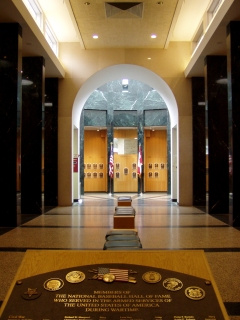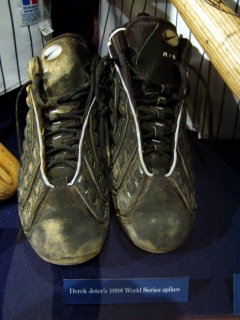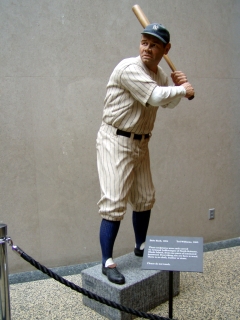National Baseball Hall of Fame
Cooperstown, N.Y.
Visited: March 28, 2004
NPS Site Visited: There's no baseball in the NPS
Local Website
Why the Baseball Hall Melancholia?
Click Here for Gab's Further Feelings on Cooperstown.
 WHAT IS IT? WHAT IS IT?
Mythical site of baseballís founding. Place of enshrinement for the baseballís greatest players and museum dedicated to the history of the game.
These ratings carry an asterisk (like Roger Maris)
Similar to the Interstates, the Baseball Hall of Fame always seems to be under repair. Our visit was no exception. They claim that the construction will be done in 2005. With our entrance ticket we received a promise that we would receive through the mail a free pass for a post-construction visit.
So in our ratings, the museum sort of gets a free pass. Sadly though, like baseball itself, we do not have the confidence that the redesign will help the Hallís dated, short-sighted and boring approach.
Update:
We never received our free 2005 tickets in the mail.
BEAUTY (1/10)
The building is ugly from the outside and a disaster zone on the inside. Cooperstown itself is a charming small town with a gorgeous view of Lake Otsego. This rating isnít for Cooperstown; itís for the museum.
HISTORIC SIGNIFICANCE (8/10)
Baseball began here. We know this, but if we hadnít, nothing in the museum would have told us. Frustration reigns in Cooperstown. You have so many historically significant items but nothing to put them into perspective, nothing explaining them at all.
At the Basketball Hall of Fame, for example, there are three simple graphic and interactive timelines next to each other. One shows basketball rule changes, one shows the significant happenings in basketballís history and the other shows what was happening in the United States (and world) at the same time. These timelines are a simple, common and helpful museum device.
Nothing of the sort here, except in the nearly hidden and out of the way Negro Leagues exhibit. Letís hope this changes.
CROWDS (3/10)
Very few people travel to Cooperstown during the off-season. Even so, we still felt crowded. A school tour was going on in the History of Baseball area. The group of 15 kids were seated on the floor effectively blocking all tourists from the 1960ís to 1990ís display cases. Couldnít they have found another place to do this? In addition, we had to wait for the Hall's few interactive displays.
 EASE OF USE/ACCESS (1/5) EASE OF USE/ACCESS (1/5)
The museum is in the middle of nowhere. Once you get to Cooperstown the museum is easy to find. The construction made a great deal of the museum inaccessible by wheelchair.
CONCESSIONS/BOOKSTORE (2/5)
A disturbingly restricted array of books. The Hall has two bookstores but neither include the classic baseball books: Ball Four, by Jim Bouton; Bill James Baseball Abstract (and its many descendents); The Great American Novel, by Philip Roth, etcÖ we could keep going.
There are no books that do not fit into the Hallís narrow description of what baseball is. No books like Rothís that use baseball secondarily as a reflection of America. The personal library owned by most baseball-loving Americans is probably more comprehensive and vibrant than what you can buy at the Hall.
COSTS (3/5)
Compared to most pay museums, the Hall of Fame is cheap. And they gave us a voucher to revisit once the construction is done. At the same time most of the National Park Historical Sites are free and it is hard to imagine that they have a lower endowment than the Baseball Hall of Fame.
RANGER/GUIDE TO TOURIST RATIO (2/5)
There were not any Guides per se. The museum's aim is to be self-guided. We asked the museum workers a few questions about what the Hall will look like when done. They were gregarious but did not answer anything. In contrast to the Basketball Hall of Fame's rampant youthfulness, every Cooperstown worker seemed to be both retired and over the age of 60. They all acted as if they knew everything about baseball and that their way was the right way. Sometimes youth is refreshing.
Weíve given this ranking a 2 instead of a 1 because of the most impressive section of the Hall: the A. Bartlett Giamatti Research Center. The Research Center is a vast archival library of the Hallís collection. Anybody can access these materials and there are Hall employees to help. Impressive. The Research Center, however, is the closest the Hall gets to inclusiveness.
TOURS/CLASSES (2/10)
The self-guided tour is confusing, uninformative and disappointing. Paradoxically the actual artifacts included in the tour are anything but substandard. The Hallís collection is amazing. But you need to know what you are looking at, as well as its significance, because the Hallís explanations are not going to help.
The Research Center boasts 12,000 hours of moving image and sound recordings. The self-guided tour utilizes almost none of these invaluable resources. We hate to compare, but at the Basketball Hall of Fame there was a large scoreboard screen that showed constant basketball highlights. In the four plus hours we were there the highlights never repeated. In the few places at Cooperstown where there was a video monitor, the highlights were on a five minute loop.
 Most disappointing was a tour we overheard given by a Hall employee to a group of students. His entire history of baseball was based on rules. Whatís right and whatís wrong. He spent five minutes explaining why Sammy Sosa was wrong when he corked his bat. We found it funny that just a short bit away was a Babe Ruth exhibit. One of the Babeís bats, the one he used to hit his 57th and 58th Home Runs in 1927, was displayed horizontally. The butt end of the bat had a circular filling that was a different color wood than the rest of the bat; a clear sign of a corked bat. Most disappointing was a tour we overheard given by a Hall employee to a group of students. His entire history of baseball was based on rules. Whatís right and whatís wrong. He spent five minutes explaining why Sammy Sosa was wrong when he corked his bat. We found it funny that just a short bit away was a Babe Ruth exhibit. One of the Babeís bats, the one he used to hit his 57th and 58th Home Runs in 1927, was displayed horizontally. The butt end of the bat had a circular filling that was a different color wood than the rest of the bat; a clear sign of a corked bat.
We are not making any accusations, but the Babe was notorious for doing whatever he could to win. And why not? The Babe was also a dynamic personality, similar to Sosa. Why couldnít the Tour Guide praise Sosa instead of castigating him for five minutes? Or praise the Babe, or praise Satchel Paige or praise Sosa. PRAISE SOMEBODY.
Baseball is a wonderful game. Celebrate it please Mr. Tour Guide. It is no wonder the kids were bored and people say baseball is dying.
FUN (5/10)
As much fun as walking around in a dimly-lit church which, sadly enough, is the intended effect.
WOULD WE RECOMMEND? (4/10)
The artifacts on display are, by themselves, extraordinary. It is the museum that is lacking. Our heartfelt recommendation is to wait to go until the museum fully reopens in 2005 and hope for the best.
TOTAL 31/80
|